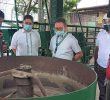On the NSCB declaration that Davao City is the least poor in Mindanao: “(That’s) good news, but it doesn’t mean that there are no more poor people in Davao. Many are still in need of work and (decent) income, especially that the city’s rate of in-migration has increased” — Mayor Sara Duterte-Carpio
By MARILOU AGUIRRE-TUBURAN
Davao Today
DAVAO CITY, Philippines — Davao is the “least poor” among cities and municipalities in Mindanao, the data from the National Statistical Coordination Board (NSCB) says so.
The figure is based on the 13.2 percent poverty incidence record of the city in the 2009’s Small Area Estimates of poverty among population by the World Bank and NSCB.
“This makes Davao City the least poor among the cities and municipalities, having the lowest poverty incidence in Mindanao,” announced Estrella Turingan, Director of NSCB-XI on Wednesday’s Club 888 media forum.
Poverty incidence is computed by subtracting the number of families who earn less than the poverty threshold from the number of population of a certain area.
Whether this is a piece of good news, is debatable. Being “least poor” is still being poor, and no less than the Davao City’s chief executive agrees.
“That’s good news, but it doesn’t mean there are no more poor people in Davao,” Mayor Sara Duterte-Carpio said in reaction through a text message to davaotoday.com.
“Many are still in need of work and (decent) income, especially that the city’s rate of in-migration has increased,” the mayor added.
How the government really sees poverty can be seen in its latest readjusted poverty threshold of 47 pesos (USD 1.12).
NSCB’s Turingan explains that a family member needs 47 pesos a day to stay at the poverty line and be considered “not poor.”
But a housewife, Eliza Montecalvo, could not reconcile how the NSCB came up with the figure, because to her, no matter how simple the viand her family prepares, 47 pesos is not just enough.
A mother of one, Montecalvo said that a pack of noodles already costs eight pesos (USD 0.19) in retail stores while an egg costs at least five pesos (USD 0.12). “A kilo of rice now even costs 40 pesos (USD 0.96) and our family consumes almost two kilos a day,” she said.
This does not include transportation, housing, clothing, water, electricity and medical costs.
The region’s current daily minimum wage, based on data from the Department of Labor and Employment’s National Wages and Productivity Commission, is PHP 301 (USD 7.19) for the service sector and PHP 291 (USD 6.95) for the agriculture sector.
However, this is a mandated wage. In most cases, the worker receives below minimum wage, with some, even receiving only 100 pesos (USD 2.38) for a day’s work.
In the city and across the region, workers of many manufacturing companies have formed unions and are at loggerheads with their employers over issues of unfair labor practice such as non-payment of minimum wage, and other benefits, including violation of security of tenure.
The minimum wage however, is still a stark contrast to what the NSCB said a family needs to meet their basic food and non-food requirements, which is 787 pesos (USD 18.76), the so-called Family Living Wage in the region based on 2008 estimates.
Davao City’s employment rate, or the total number of employed persons vis-à-vis the total number of persons in the labor force, rose to 95.4 percent in 2011 from the 93.9 percent in 2010.
Its unemployment rate, or the population 15 years old and above (or the labor force) who are reported to be without work is pegged at 4.6 percent as of October 2011, based on the NSO’s Labor Force Survey.
This includes those seeking work or not seeking work because either they believe there are no work available, are still awaiting results of job applications, or those who could not work due to a temporary illness or disability.
Meanwhile, the underemployment rate or those in the labor force who express desire to have additional hours of work in their present jobs, including those who intend to have a new job with longer working hours, is pegged at 16.4 percent.
Davao is a city with a population of 1.44 million, based on the National Statistics Office (NSO)’s 2010 data, a surge from the 1.3 million record in 2007, mainly attributed to the migration of individuals from areas outside Davao.
“That is why we need to generate more investments so that we can provide more jobs,” Mayor Duterte said.
While Kadayawan, a yearly festival observed every August, by tradition is an occasion that denotes celebration for blessings of abundance, in these hard times, it has become a chance for the city to spur economic activities for the benefit of the people. More than 70,000 tourists are expected to pour into the city for the festivity.
Abundance, besides, is a misnomer for a city that remains to be, still among the poor.
Three cities and two municipalities outside of Davao Region also make it to the top ‘least poor’ list. They are Tacurong and Kidapawan cities in SoCCSKSarGen Region, Zamboanga City in the Zamboanga Peninsula and, Marantao and Lamitan municipalities in the Autonomous Region in Muslim Mindanao (ARMM). They posted a poverty incidence of 18.5 percent, 19.2 percent, 19.9 percent, 19.6 percent and 20.5
percent, respectively.
Meanwhile, six of the 10 poorest municipalities in Mindanao are in the Zamboanga Peninsula Region, while two are in the Davao Region and one each in the ARMM and Northern Mindanao Region.
The municipality of Siayan in Zamboanga del Norte is the ‘most poor’ amongst Mindanao cities and municipalities with 79.9 percent poverty incidence. This is followed by the municipalities of Baliguian in Zamboanga del Norte, Jose Abad Santos and Sarangani in Davao del Sur, Godod and Gutalac in Zamboanga del Norte, Pandag in Maguindanao, Tagoloan in Lanao del Norte, Mabuhay in Zamboanga Sibugay and Manukan in Zamboanga del Norte. Theay posted a poverty incidence of 75.3 percent, 72.3 percent, 72.1 percent, 71.1 percent, 70.4 percent, 70.1 percent, 69.4 percent, 68.9 percent and 68.2 percent, respectively. (Marilou Aguirre-Tuburan/davaotoday.com)










